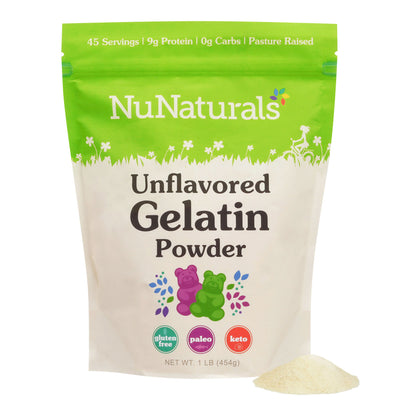So what's the big deal with bone broth these days? The answer has to do with gelatin and collagen... here's the scoop.
What exactly are collagen and gelatin?
Raw collagen is the primary protein that makes up most of the connective tissues in the body, like ligaments, tendons, muscles, joints, skin, and bones. When you cook collagen, say when you simmer bones to make broth, you are turning the collagen from the bones into gelatin. Gelatin is the reason a good broth will gel to a solid when it cools. Gelatin can be even further broken down into finer protein particles called collagen hydrolysate, also known as hydrolyzed collagen or collagen peptides. Both gelatin and hydrolysated collagen have the same amino acid profile and protein content to benefit from but come in different structures with different application benefits. Some people feel that collagen hydrolysate is easier to digest because of its smaller protein particle makeup. However, it will not "gel" like gelatin so it doesn't have the same cooking applications. Another difference is that collagen hydrolysate will dissolve in cold or hot liquids, unlike gelatin that will only dissolve in hot liquid. You can add collagen hydrolysate to pretty much anything as a way to consume, where gelatin has slightly more specific applications due to the gel-like texture it creates. Some people find the texture of gelatin undesirable when added to their smoothies or tea for instance, but for making pudding, gummy candy, sauces, soups, or homemade jellies and jams it's gelicious!

Why would someone want to incorporate gelatin or collagen in their diet?
Because collagen is the main protein that makes up most of the connective tissue in our body and we don't produce as much collagen as we get older, there is evidence that consuming it can benefit our joints, bones, skin, and other connective tissues. As a result, there are many collagen supplements on the market today. Aside from its awesome amino acid content (like proline and glycine), and a hefty amount of protein, gelatin, and collagen may also have intestinal healing effects. This is why the doctor-developed-diet called GAPS, which is used to heal ailments such as "leaky gut", incorporates lots of bone broth. Gelatin is also suggested to have been one of the first foods used medicinally in China because it is shown to be great for people with food allergies or sensitivities. For athletic people looking for a post work out protein boost, collagen and gelatin are a great after workout option that will not only give a powerful dose of instant protein but can also aid in the repair and recovery of the muscles and connective tissues.
To sum it up...
We'll admit that bone broth is a much more appetizing way to consume collagen than how cavemen used to do it. But making bone broth is a time-consuming process so it's tough to keep bone broth on hand at all times, and can be hard to maintain as a consistent way to get the benefits of gelatin and collagen on a regular basis. If you're interested in reaping the benefits that gelatin and collagen have to offer, but are looking for a more convenient way to do so, then your answer may be in gelatin-based kitchen creations or utilizing the versatility and convenience of adding hydrolysate collagen to your food or beverages.

